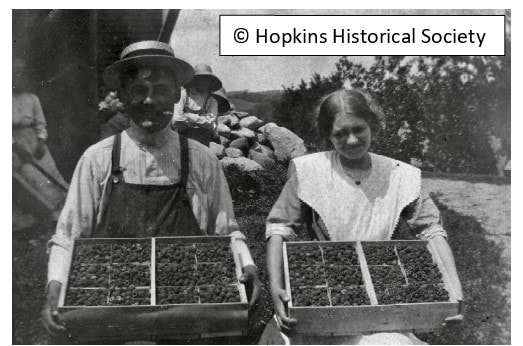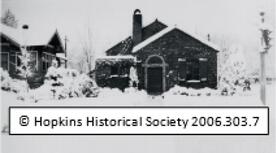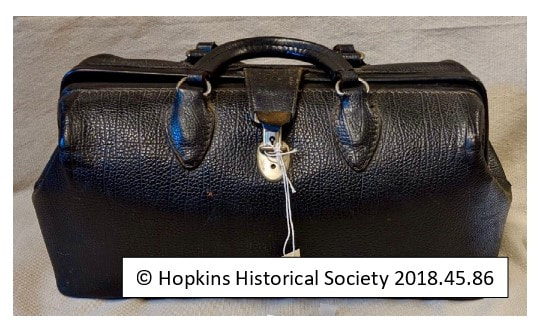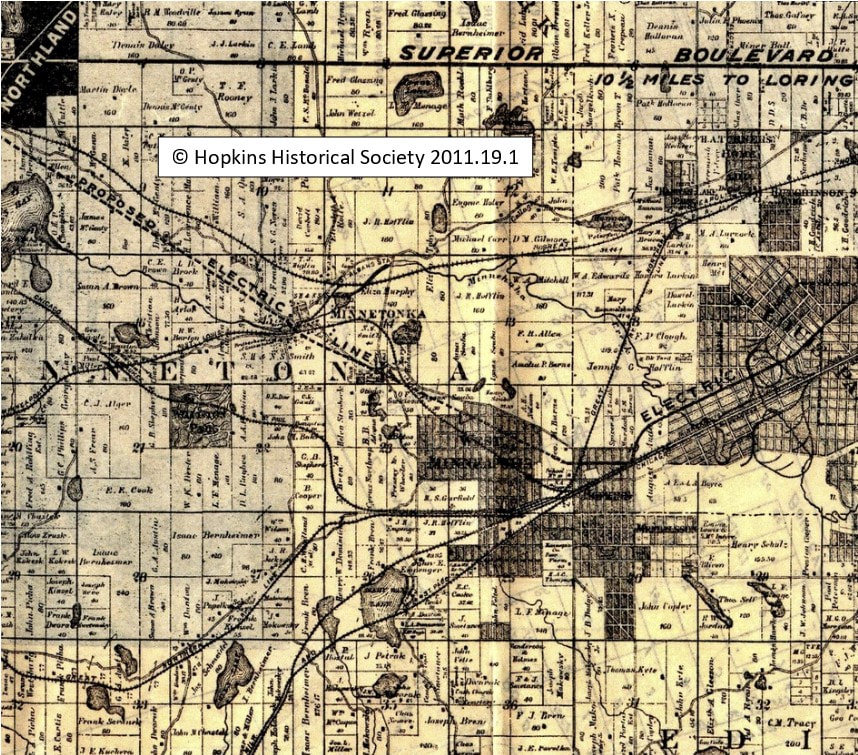Hopkins Trivia! How much do you know about Hopkins?
Provided by Mary Romportl
Click on each question
to reveal the answer
Click on each question
to reveal the answer
1. In what year did the first raspberry festival take place? Click to reveal
2. Which Hopkins young woman became Miss America? CLICK TO REVEAL
|
Bebe Shopp.
She was never a Raspberry queen or princess, but had been entered by Daniels’ Photography Studio in the 1948 “Stairway to Stardom” contest at Excelsior Amusement Park. Bebe Shopp then became Miss Minnesota and went on to win the Miss America pageant that same year. Her performance in the talent portion of the Miss America contest was playing the vibraphone (xylophone). |
3. What was the “banking practice” developed by John Feltl in 1886? CLICK TO REVEAL
|
The method of plowing furrows along rows of raspberry plants, bending down the pruned bushes, and covering the entire plants with a bank of soil for safe winter storage. Other growers adopted not only this Feltl practice but also the significant contributions by Joe and John Empanger to the development of better raspberry varieties.
|
4. What was the name of the pre-1928 incorporated village that later became the city of Hopkins? Click to reveal
|
West Minneapolis
The area was first part of Minneapolis and Minnetonka Townships, but became the Village of West Minneapolis in 1893. This was not long after the Minneapolis Threshing Machine Company had formed the West Minneapolis Land Company which platted the city streets. It was not until 1928 that Hopkins became the official name of the village, though many locals had called it that for years. In 1947 the Village of Hopkins became the City of Hopkins. This photo was taken from the old Hopkins water tower at Minneapolis Threshing Machine Company—later to become Minneapolis-Moline—both major farm machinery manufacturers. Photo from the Hopkins Historical Society collection |
5. What was the price of raspberries in the early years of the Hopkins Raspberry Festival? click to reveal
|
25 cents for 3 pints.
Growing and picking raspberries was time-consuming, hard work, and expensive for the growers who hoped to get a fair price at market. Adults, particularly many women, were raspberry pickers in the early years. Some were wives, daughters, or relatives of Hopkins growers; but some pickers were hired and drove in from as far away as Silver Lake and Waconia—a long commute in those years. Sometimes, though, they would board with the grower’s family for the picking season—the month of July. One worker remembered picking four crates in a 14-hour day—with 24 boxes of berries in each crate. She was paid 48 cents per crate (which held 12 boxes). In later years when adult labor became more expensive, Hopkins children and teens often worked in the raspberry fields. |
6. What was located on the site of the present Hopkins Center for the Arts in the 1940s and ’50s? Click to reveal
7. Who was Hopkins named after and why? click to reveal
Harley H. Hopkins
His home was located across Excelsior Avenue from the railroad depot named after him (arranged in a deal with the railway when he gave them some of his land). Harley was the claim agent and station manager and also postmaster. The Hopkins Post Office was located in the station in 1872 and later operated out of the Hopkins’ home. (This site is now occupied by the 169 interchange and the Cargill buildings at Excelsior Crossings.) The town was named for him about 46 years after his death especially since the depot and the post office bore his name.
Harley’s son Chester Hopkins was the first president (mayor) of the Village of West Minneapolis; and their ancestor Stephen Hopkins was a signer of the Declaration of Independence and a member of the First Continental Congress from Rhode Island.
His home was located across Excelsior Avenue from the railroad depot named after him (arranged in a deal with the railway when he gave them some of his land). Harley was the claim agent and station manager and also postmaster. The Hopkins Post Office was located in the station in 1872 and later operated out of the Hopkins’ home. (This site is now occupied by the 169 interchange and the Cargill buildings at Excelsior Crossings.) The town was named for him about 46 years after his death especially since the depot and the post office bore his name.
Harley’s son Chester Hopkins was the first president (mayor) of the Village of West Minneapolis; and their ancestor Stephen Hopkins was a signer of the Declaration of Independence and a member of the First Continental Congress from Rhode Island.
8. The Hopkins home reportedly had the first ______ in Hopkins. What was it? click to reveal
9. Who was the first doctor in Hopkins? click to reveal
|
Dr. Catherine Burnes.
“Doc Kate” served Hopkins from 1886-1917. She was also the first woman to graduate from the University of Minnesota medical school. She was known to pin a $10 bill to her dress to give to any family she visited who was in need. |
This medical bag belonged to Dr. James A. Blake who delivered over 3000 babies in Hopkins.
|
10. By 1934, how many female postmasters had served Hopkins? click to reveal
|
Three.
Florinda Hopkins, daughter of Harley Hopkins was appointed by President James Garfield in 1882 after her father’s death. Anna Eidam was appointed in 1898 to serve out her husband’s term after he died. And Florence Markham was appointed by President Franklin D. Roosevelt and served from 1934 until 1944. |
11. What 2 Hopkins schools were named after favorite, long-time Hopkins teachers? click to reveal
|
All teachers in the photo are (presumably from bottom step to top): Margaret (Hughes) Henks, Doris (Elliott) Empanger, Celestine Swanson, Irene (Rudser) Schwan, Rodine Holmes, Alice Smith, Berniece (Ortho) Snyder, and Katherine Curren.
|
1. Katherine Curren Elementary, built in 1946 and closed in 2007 for budgetary reasons. Miss Curren taught from 1905-1949. When she got off the train at the Hopkins Depot in 1905, the town had not grown out that far yet. It is said that she wondered, “Where the heck is Hopkins?”
2. Alice Smith Elementary, serving Hopkins from 1952 to the present. Alice Smith taught from 1919-1949 and was a well-loved teacher. In this photo, Katherine Curren is pictured top right and Alice Smith is top left. |
12. In the early 1970’s Antoinette (Toni) St. Pierre of Hopkins Eisenhower High School and Peggy Brenden of St. Cloud Technical High School initiated a lawsuit that was tied to what landmark legal decision? click to reveal
|
Title IX of the Education Amendments Act of 1972.
Title IX is a federal law that states: "No person in the United States shall, on the basis of sex, be excluded from participation in, be denied the benefits of, or be subjected to discrimination under any education program or activity receiving Federal financial assistance." Furthermore, the government ruled that if schools wanted federal money, they could not discriminate because of gender. Meanwhile in Minnesota, United States District Judge Miles Lord ruled in the girls’ precedent-setting lawsuit, “Brenden v Independent School District 742,” that these high school girls were qualified to participate on boys’ sports teams and the teams they belonged to could not be disqualified for doing including girls. The lawsuit brought by St. Pierre and Brenden was the first suit to cite the Title IX legislation and established that athletics were part of education. Minnesota was thus ahead of other states in establishing regulations and programs to support the rights of females to participate in sports. Their suit gathered national attention. Toni St. Pierre competed on the Hopkins boys’ cross country and skiing teams at Eisenhower. She was also the 1973 state champion in the half mile and mile races, and she set a national record in the half mile. |
13. The Dow House was long admired as the grandest home in Hopkins. How did Daniel and Belinda Hamilton Dow earn the funds to build their 15-room mansion? click to reveal
|
They sold land to investors who then sold it to the railways and Minneapolis Threshing Machine company. Belinda Dow especially owned considerable land in town. Their home included a third-floor ballroom and a bathtub. It was the center of early Hopkins social life. It stood on a hill along with an old Hopkins water tower in the block where the Hopkins Post Office and Auto Mall are now located. After housing the Hopkins Library for years, the structure was deemed unsafe and torn down in the 1970s before historic preservation gained popularity.
|
14. Hennepin County was one of the few counties in the state to pay a salary to the wife of the superintendent of what institution? click to reveal
|
The Hennepin County Poor Farm.
Poor farms were located in every county in most states. They were run by a superintendent and, in most cases, the superintendent’s wife was just expected to fulfill the role of matron for no pay. The Hennepin County Poor Farm was a 400-acre site located just west of what is now Highway 169 and near 5th Ave. S. and was opened in 1865. Before this, the poor and disabled were housed in individual homes. The newest structure pictured was built in 1926 and housed 234 people by 1930. The idea was that the residents would work the land to raise their food and provide income for the facility, but many were not able to work. Even Harley Hopkins provided the farm with food from his nearby farmlands. The employees of the farm and institution were mostly Hopkins residents. The Poor Farm shut its doors and sold the property in 1953. |
15. In 1901, Hopkins was known as the largest _________ west of Chicago. What was that? click to reveal
a. farm area
b. railroad hub
c. industrial center
a. farm area
b. railroad hub
c. industrial center
|
Hopkins was the largest railroad hub west of Chicago.
Trains passing west and east would converge in Hopkins before being sent north or south. Some of the lines would bypass Minneapolis and St. Paul. There were seven tracks passing through town carrying freight lines and over 40 passenger trains daily. The Depot Coffee House was the newer building for the Minneapolis & St. Louis (M & StL) rail line which built the first station there after securing land from Harley Hopkins in 1870. |

















